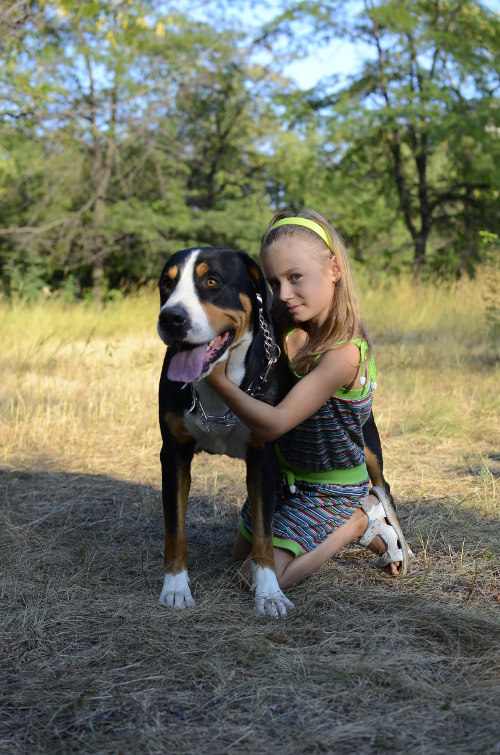How one should act in the order to avoid a strange dog attack. We
will consider the point of child's actions when it meets a strange
dog. It is a responsibility of each dog owner to teach his friends,
and especially children, the right actions in this situation. Who
else can understand and explain dog's psychology better that a
practicing dog trainer? Who else except of us can teach friends,
relatives, how to treat a strange dog, especially if it is a
fighting breed walking without a leash.
First of all, let's make it clear why a dog attacks a casually met person. Within the whole variety of concrete situations, there are actually just four reasons:
1. Expressing of territorial aggression. A dog is a territorial animal, that acts accordingly in definite circumstances. Depending on the circumstances, in which a dog was bred and trained, territorial behavior is expressed more or less.
2. Aggression expressed to protect its "pack" (family). Dogs are not only territorial beings, but also gregarious animals. And pack always protects its members, even if it is at a strange territory.
3. Aggression of prey. Inborn reaction of any dog behavior is the eager to prey practically any moving objects.
4. Dominating aggression, pointed to make its level and rate higher in the pack.
The main rules, keeping to which will let to minimize the risk of strange dog aggression.
1. Never come to the territory with dogs if there are no people to control these dogs.
2. If you are already at such territory ans a dog attacks you, you should:
not run and shake hands, not turn back to a dog, in the order not to add an aggression of pray to the territorial one;
organize protection from a possible bite, for example, turn your jacket off and wrap it over your arm;
arranging to meet a dog and keeping an eye on it, walking backwards, leave the territory.
Remember, that the point of the dog is to make you leave its territory, and possible biting is only one of the means to achieve this point. That's why a dog will let you leave. because it does not like the idea of struggling with a quite ready for attack opponent.
3. If you see a dog without a lead and a muzzle, don't come to a person it s walking with, don't try to talk to him and even don't look at him. Be especially careful if a dog is walking with an elderly person or a child - in the case of attack they will not be able to stop their pet and a dog will probably not react their commands.
If a person walking with a dog suddenly feels bad and a dog shows intentions to protect its owner, don't try to manage it and come closer to the person. It is better to call the police and ambulance.
4. If suddenly, without any reasons, a dog is quickly coming up to you, stop and don't move your hands. Look attentively around and make sure that you have not provoked territorial aggression. A dog coming up to you and seeing no reason to play with you or prey you will probably leave you alone.
5. Even if you are acquainted to a dog, don't come up to its
doghouse, plate or toys and don't touch this dog. If
circumstantially you caused dominating aggression (you saw that you
stepped a bone at a doghouse and a dog coming up to you and
growling), go aside fast and leave a dog and its "property" alone.
Usually it is enough to stop aggression.

And the last: if you have no experience in communication with dogs, don't try to frighten a strange dog outside. Of course, dominance is the best way to soothe aggression, but here you should evaluate your abilities and powers of dog nervous system. If you fail - bites are unavoidable.
We will stop especially at expression of aggression to children. Dogs treat children a little bit different. There is almost no territorial and defending aggression in this case, but the aggression of prey and play is quite strong. A dog may also express dominating aggression. In addition, children may act the way adults would never even think of. For example, to throw stones to a dog behind a fence (no one guarantees that the dog will be behind the fence always).
The rules listed below are to be taught to each child:
1. Never tease a dog.
2. Never touch dog's toys and food.
3. If a strange dog is coming up - never run and shake hands. Whatever a dog may do - stay still and silent.
We hope that this article will help dog owners to understand behavior of their dogs and to control their pets more clearly, and people who meet dogs only outside - to avoid a lot of unpleasant situations.
It is generally and all too readily assumed, that a dog has not to
wear a muzzle in training, and if it has to, than only in the cases
of extreme necessity. The training practice of the latest years
convinced that a dog is well trained muzzled if it is trained to it
gradually. A muzzle trains a dog to a discipline, it distracts its
attention from other dogs, and at the cases of casual breakdown,
fights a muzzle protects it from injures. In addition, a trainer
works with a dog more assured and safe. The necessity of a muzzle is
evident, when a dog is controlled without a lead. A muzzle
interferes some commands, picking up objects, developing of anger
and tracking. While general training commands performing, delicacy
is given through a muzzle. Metal dog muzzle is comfortable in this
case, but it cannot be used in frosty weather -5' C. For winter you
need a rubber coated dog muzzle.